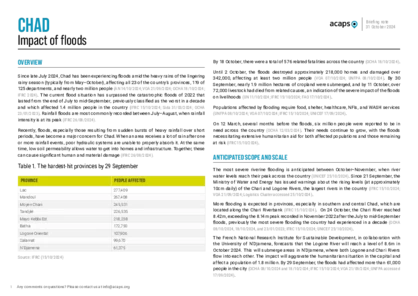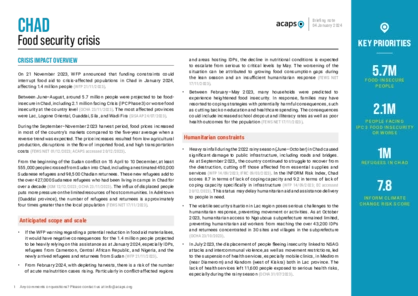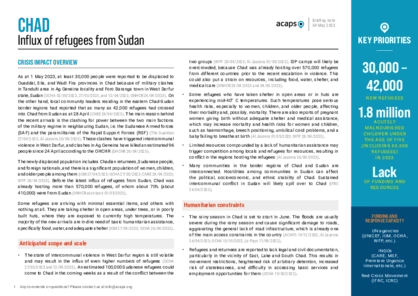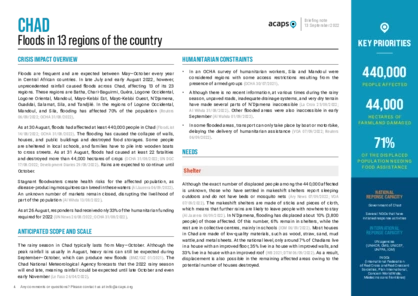Latest updates on country situation
06 October 2025
A cholera outbreak in eastern Chad continues to spread, affecting ten health districts across Guéra, Ouaddaï, and Sila provinces. By 4 October 2025, the epidemic had recorded 2,657 patients (88% of whom arrived in moderate or severe dehydration) and 149 deaths, nearly 43% of which occurred outside health facilities. Despite mass vaccination campaigns, challenges persist owing to poor WASH infrastructure and limited healthcare access in overcrowded refugee camps and host communities. (Govt. Chad 05/10/2025, MSF 03/10/2025)
01 September 2025
By 29 August 2025, the cholera outbreak in eastern Chad was still worsening, with over 1,000 cases and 68 deaths reported in Ouaddai and Sila provinces. With a case fatality rate of 6.8%, the outbreak is among the deadliest currently active in Africa. Most cases are among Sudanese refugees and host communities living in overcrowded conditions. Limited access to treatment and poor WASH infrastructure continue to fuel transmission despite vaccination and response efforts. (ECHO 29/08/2025, RFI 30/08/2025, WHO 29/08/2025)
04 August 2025
On 25 July 2025, the Ministry of Public Health officially declared a cholera outbreak in Dougui refugee camp in Ouaddai province (eastern Chad). Since 13 July, the camp has recorded 128 suspected cases and five deaths out of a population of 20,000. The outbreak is thought to be linked to the recent refugee influx from cholera-affected areas of Sudan. Lack of access to safe drinking water for camp residents and poor sanitation conditions, including open defecation and overflowing latrines, raise concerns about a larger outbreak. The start of the rainy season is likely to lead to flooding and heighten risks of waterborne diseases, which, alongside the arrival of refugees directly from cholera-affected areas in Sudan, could contribute to a further spread of the outbreak. The most urgent needs include access to safe drinking water, improved sanitation, and health services. (Govt. Chad 28/07/2025, RFI 30/07/2025, IMC 01/08/2025)
27 May 2025
The conflict in Sudan continues to drive large-scale displacement into Chad, mainly owing to the escalation of violence in Al Fasher town (North Darfur). Clashes between rival armed groups and attacks on civilians here and in other insecure areas are increasing. Chad is the second African country most affected by the Sudan conflict, hosting 28.3% of all Sudanese refugees by May 2025. Between late April and 23 May, more than 47,000 Sudanese refugees arrived in the eastern provinces of Ouaddaï, Sila, and Wadi Fira. This brings the total number of Sudanese refugees hosted in Chad to more than 830,000. Most arrive in extremely vulnerable conditions and settle in spontaneous overcrowded sites lacking adequate shelter, clean water, and sanitation. Nearly half are children, with protection risks increasing, especially for unaccompanied minors. The rainy season (June–September) is expected to worsen humanitarian access, further limiting mobility and supply routes. (UNHCR 19/05/2025, Govt. Chad/WHO 23/05/2025, UNICEF 23/05/2025)
16 December 2024
By 15 December 2024, over one million Sudanese refugees were registered in Chad, more than 719,000 of whom came after the start of the conflict in Sudan in mid-April 2023. The majority live in formal and informal overcrowded camps in Ennedi-Est, Ouaddai, Sila, and Wadi Fira provinces. These people need access to shelter, food, water, NFIs, healthcare, and education. (UNHCR accessed 18/12/2024, UNHCR 03/12/2024), WHO 25/11/2024)
30 October 2024
Clashes in West Darfur state, Sudan, have intensified, leading to a surge in the number of Sudanese refugees arriving in Chad. Since April 2023, over 680,000 Sudanese refugees have been displaced to Chad, with 49,000 arriving in October. Camps in Chad face severe overcrowding and shortages in food, water, and shelter. (IRC 28/10/2024, TNA 17/10/2024)
17 September 2024
The impact of widespread flooding from heavy rainfall since mid-July 2024 is heightening. Reports indicate that the floods had affected almost 1.5 million people across the 23 provinces by 17 September, killing 341 people, damaging at least 265,000 houses, submerging over 250,000 hectares of agricultural land, and restricting humanitarian access. Eight provinces (Batha, Guera, Lac, Logone Oriental, Mandoul, Mayo Kebbi Est, Salamat, and Tandjilé) are among the hardest hit, with about 1,179,000 people affected. With their livelihoods devastated, these people need shelter, health, protection, and food aid and assistance. The lack of access to WASH services aggravates the risks of a cholera epidemic across the country. (UNFPA 12/09/2024, UNICEF 17/09/2024, RFI 16/09/2024)
current crises
in
Chad
These crises have been identified through the INFORM Severity Index, a tool for measuring and comparing the severity of humanitarian crises globally.
TCD001 - Complex crisis
Last updated 30/11/2025
Drivers
Conflict/ Violence
Floods
Crisis level
Country
Severity level
4 High
Access constraints
3.0
TCD003 - Conflict in Lac province
Last updated 30/11/2025
Drivers
Conflict/ Violence
Crisis level
Country
Severity level
3.4 High
Access constraints
2.0
TCD004 - Displacement from CAR
Last updated 30/11/2025
Drivers
International Displacement
Crisis level
Country
Severity level
2.2 Medium
Access constraints
2.0
TCD005 - Displacement from Sudan
Last updated 30/11/2025
Drivers
International Displacement
Crisis level
Country
Severity level
3.1 High
Access constraints
2.0
Analysis products
on
Chad
04 January 2024
Chad: food security crisis
DOCUMENT / PDF / 387 KB
From the beginning of the Sudan conflict on 15 April to 10 December, at least 555,000 people crossed from Sudan into Chad, including an estimated 450,000 Sudanese refugees and 98,500 Chadian returnees. These new refugees add to the over 427,000 Sudanese refugees who had been living in camps in Chad for over a decade.
05 May 2023
Chad: influx of refugees from Sudan
DOCUMENT / PDF / 555 KB
As at 1 May 2023, at least 30,000 people were reported to be displaced to Ouaddai, Sila, and Wadi Fira provinces in Chad because of military clashes in Tandulti area in Ag Geneina locality and Foro Baranga town in West Darfur state, Sudan.
17 August 2022
Lake Chad Basin: Impact of extreme weather & climate events on food security
DOCUMENT / PDF / 1 MB
This report aims to explore the impact of extreme weather and climate events on the humanitarian situation in the Lake Chad Basin. Since the 1970s in West and Central Africa, river floods and agricultural and ecological droughts have been increasing while average rainfall has been decreasing. These phenomena have an impact on availability of resources and land, and consequently on the economic and living conditions of the regions’ populations.






